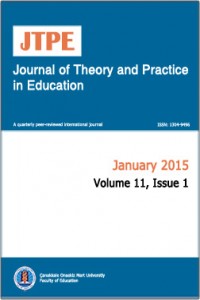Abstract
This is a sample study for Project based learning for the subjects as data analysis, the interpretation of tables and graphics in the Secondary Mathematics Course Program for 11th and 12th grades. First of all, a graph showing the changes in the borders of Ottoman Empire with respect to years was obtained. Then, the reigns of the Sultans were shown on that graphic. Thus, we have analyzed the graphic in order to depict the five periods as to how the borders changed respectively. Finally, we have analyzed to see whether there is a significant relationship between the changes of the borders with respect to years and the reigns of the Sultans
References
- Aladağ, S. (2008). İlköğretim Matematik Öğretiminde Proje Tabanlı Öğrenme Yaklaşımının Öğrencilerin Akademik Başarısına Etkisi. Türkiye Sosyal Araştırmaları Dergisi, 12(2), 157–170.
- Demirel ve Diğerleri (2000). Proje Tabanlı Öğrenme Modelinin Öğrenme Sürecine ve Öğrenci tutumlarına Etkisi. IX. Eğitim Bilimleri Kongresi Bildirisi, Bolu.
- Demirhan, C., & Demirel, Ö. (2003). Program geliştirmede proje tabanlı öğrenme yaklaşımı. Abant İzzet Baysal Üniversitesi Eğitim Fakültesi Dergisi.
- Erdem, M., & Akkoyunlu, B. (2002). İlköğretim sosyal bilgiler dersi kapsamında beşinci sınıf öğrencileriyle yürütülen ekiple proje tabanlı öğrenme üzerine bir çalışma. İlköğretim Online, 1(1).
- Ersoy, Y. (2011). Ağaçların Boyunun Uzaması (Sekoya Ağacı). Proje Tabanlı Matematik ve Fen Bilimleri Öğretimi Semineri ve Çalıştayı, Tekirdağ.
- Esemono, (2010). Osmanlı Devleti'nin yükselişi ve çöküşü. http://commons.wikimedia.org/wiki/File:Rise_and_Fall_of_the_Ottoman_Empire_1300-1923.gif.
- MEB, (2013). Ortaöğretim Matematik Dersi (9, 10, 11 ve 12. Sınıflar) Öğretim Programı. http://ogm.meb.gov.tr, (alıntı 02 Ocak 2015) .
- MEB, (2013). Ortaöğretim Tarih Dersi 10. Sınıf Öğretim Programı. http://ogm.meb.gov.tr/, (alıntı 02 Ocak 2015) .
- Öztürk, Ş. (2009). Fen ve Teknoloji Dersinde Proje Tabanlı Öğrenme (PTÖ) Yönteminin Yeri ve Önemi. I. Uluslararası Türkiye Eğitim Araştırmaları Kongresi, Çanakkale On Sekiz Mart Üniversitesi.
- Saracaloğlu, A. S., Akamca, G. Ö., & Yeşildere, S. (2006). İlköğretimde Proje Tabanlı Öğrenmenin Yeri. Journal of Turkish Educational Sciences, 4(3), 241-260
- TTK, Osmanlı Padişahları, http://www.ttk.gov.tr, (alıntı 02 Ocak 2015).
Mathematical analysis of data on Ottoman history as an application of project based learning model / Proje tabanlı öğrenme modelinin bir uygulaması olarak Osmanlı tarihi verilerinin matematiksel analizi
Abstract
This is a sample study for Project based learning for the subjects as data analysis, the interpretation of tables and graphics in the Secondary Mathematics Course Program for 11th and 12th grades. First of all, a graph showing the changes in the borders of Ottoman Empire with respect to years was obtained. Then, the reigns of the Sultans were shown on that graphic. Thus, we have analyzed the graphic in order to depict the five periods as to how the borders changed respectively. Finally, we have analyzed to see whether there is a significant relationship between the changes of the borders with respect to years and the reigns of the Sultans.
References
- Aladağ, S. (2008). İlköğretim Matematik Öğretiminde Proje Tabanlı Öğrenme Yaklaşımının Öğrencilerin Akademik Başarısına Etkisi. Türkiye Sosyal Araştırmaları Dergisi, 12(2), 157–170.
- Demirel ve Diğerleri (2000). Proje Tabanlı Öğrenme Modelinin Öğrenme Sürecine ve Öğrenci tutumlarına Etkisi. IX. Eğitim Bilimleri Kongresi Bildirisi, Bolu.
- Demirhan, C., & Demirel, Ö. (2003). Program geliştirmede proje tabanlı öğrenme yaklaşımı. Abant İzzet Baysal Üniversitesi Eğitim Fakültesi Dergisi.
- Erdem, M., & Akkoyunlu, B. (2002). İlköğretim sosyal bilgiler dersi kapsamında beşinci sınıf öğrencileriyle yürütülen ekiple proje tabanlı öğrenme üzerine bir çalışma. İlköğretim Online, 1(1).
- Ersoy, Y. (2011). Ağaçların Boyunun Uzaması (Sekoya Ağacı). Proje Tabanlı Matematik ve Fen Bilimleri Öğretimi Semineri ve Çalıştayı, Tekirdağ.
- Esemono, (2010). Osmanlı Devleti'nin yükselişi ve çöküşü. http://commons.wikimedia.org/wiki/File:Rise_and_Fall_of_the_Ottoman_Empire_1300-1923.gif.
- MEB, (2013). Ortaöğretim Matematik Dersi (9, 10, 11 ve 12. Sınıflar) Öğretim Programı. http://ogm.meb.gov.tr, (alıntı 02 Ocak 2015) .
- MEB, (2013). Ortaöğretim Tarih Dersi 10. Sınıf Öğretim Programı. http://ogm.meb.gov.tr/, (alıntı 02 Ocak 2015) .
- Öztürk, Ş. (2009). Fen ve Teknoloji Dersinde Proje Tabanlı Öğrenme (PTÖ) Yönteminin Yeri ve Önemi. I. Uluslararası Türkiye Eğitim Araştırmaları Kongresi, Çanakkale On Sekiz Mart Üniversitesi.
- Saracaloğlu, A. S., Akamca, G. Ö., & Yeşildere, S. (2006). İlköğretimde Proje Tabanlı Öğrenmenin Yeri. Journal of Turkish Educational Sciences, 4(3), 241-260
- TTK, Osmanlı Padişahları, http://www.ttk.gov.tr, (alıntı 02 Ocak 2015).
Details
| Primary Language | Turkish |
|---|---|
| Journal Section | Makaleler |
| Authors | |
| Publication Date | January 21, 2015 |
| Submission Date | January 21, 2015 |
| Published in Issue | Year 2015 Volume: 11 Issue: 1 |


